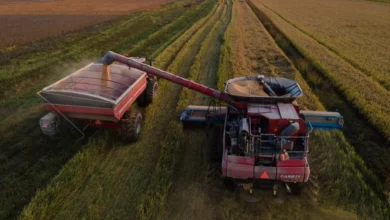Climate change cut global wheat and corn output by more than 3 percent over the past three decades compared to growth projections without a rise in temperatures, a study found on Friday. The impacts translated into up to 20 percent higher average commodity prices, before accounting for other factors, according to the paper published in the journal Science.
Crop yields rose over the period for example as a result of improvements in practices and plant breeding, and the isolated, negative impact of climate change was equivalent to about one tenth of those advances.
But that varied widely between countries with Russia, Turkey and Mexico more affected for wheat, for example.
The isolated impact of climate change on wheat and corn was a warning of the future food supply and price impact from an expected acceleration in warming, the paper said.
"Climate changes are already exerting a considerable drag on yield growth," said the study titled "Climate Trends and Global Crop Production Since 1980."
The authors used crop yield models with and without changes in temperature and rainfall to show global falls in wheat output of 5.5 percent and 3.8 percent for corn as a result of climate change from 1980-2008.
That was equivalent to the entire annual corn crop of Mexico, or the wheat crop of France, the European Union's biggest producer, it said.
Nationally, among the worst affected was Russia, with a nearly 15 percent cull in wheat, while the United States was unaffected.
For soybeans and rice, climate change winners and losers balanced each other out. For example, rice gained in cooler, higher latitude countries.
The paper, written by scientists from US institutions including Stanford University and Columbia University, noted that adaptation responses, such as advances in crop breeding, could soften the blow of future warming.
"Without successful adaptation, and given the persistent rise in demand for maize and wheat, the sizable yield setback from climate change is likely incurring large economic and health costs," it said.
The study did not account for the impact of higher atmospheric levels of carbon dioxide (CO2), the main manmade greenhouse gas which is also a raw ingredient of, and so spurs, crop growth – called CO2 fertilization.
Including that effect would likely see a net benefit from climate change on soybeans and rice since 1980, it said.
Conversely, the paper did not account for extreme heatwaves or rainfall, which means the findings could under-estimate the global warming impact.
The output losses since 1980 translated into 18.9 percent or 6.4 percent higher average commodity prices, excluding and including the effect of CO2 fertilization respectively.
The models were based on actual data which showed rising temperatures across nearly all the world's main growing regions with the exception of the United States, which saw a slight cooling over the period. Rainfall trends were more muted.
Concerns have grown in the past few weeks for the impact of droughts on wheat yields in parts of the US and Europe.




